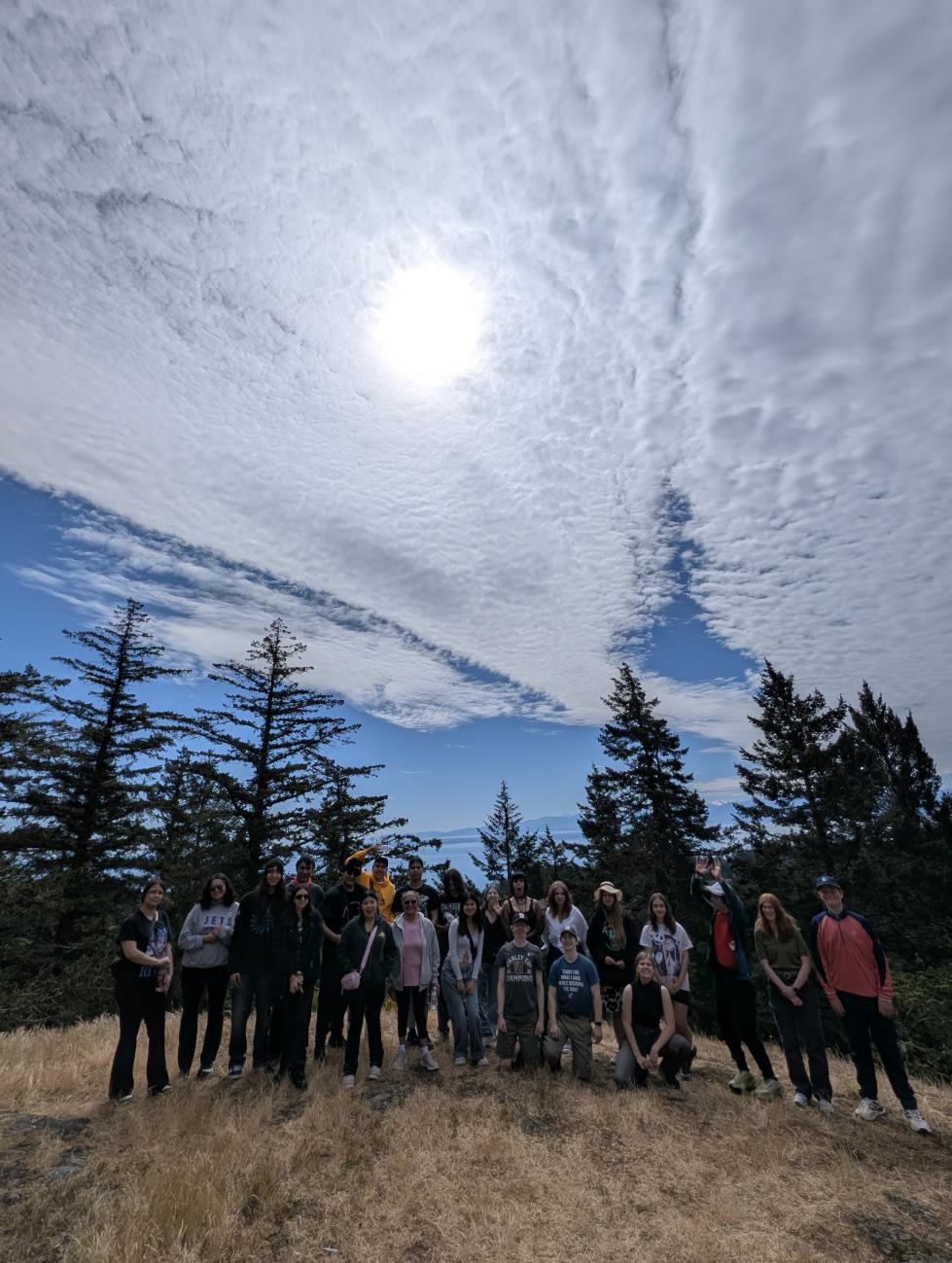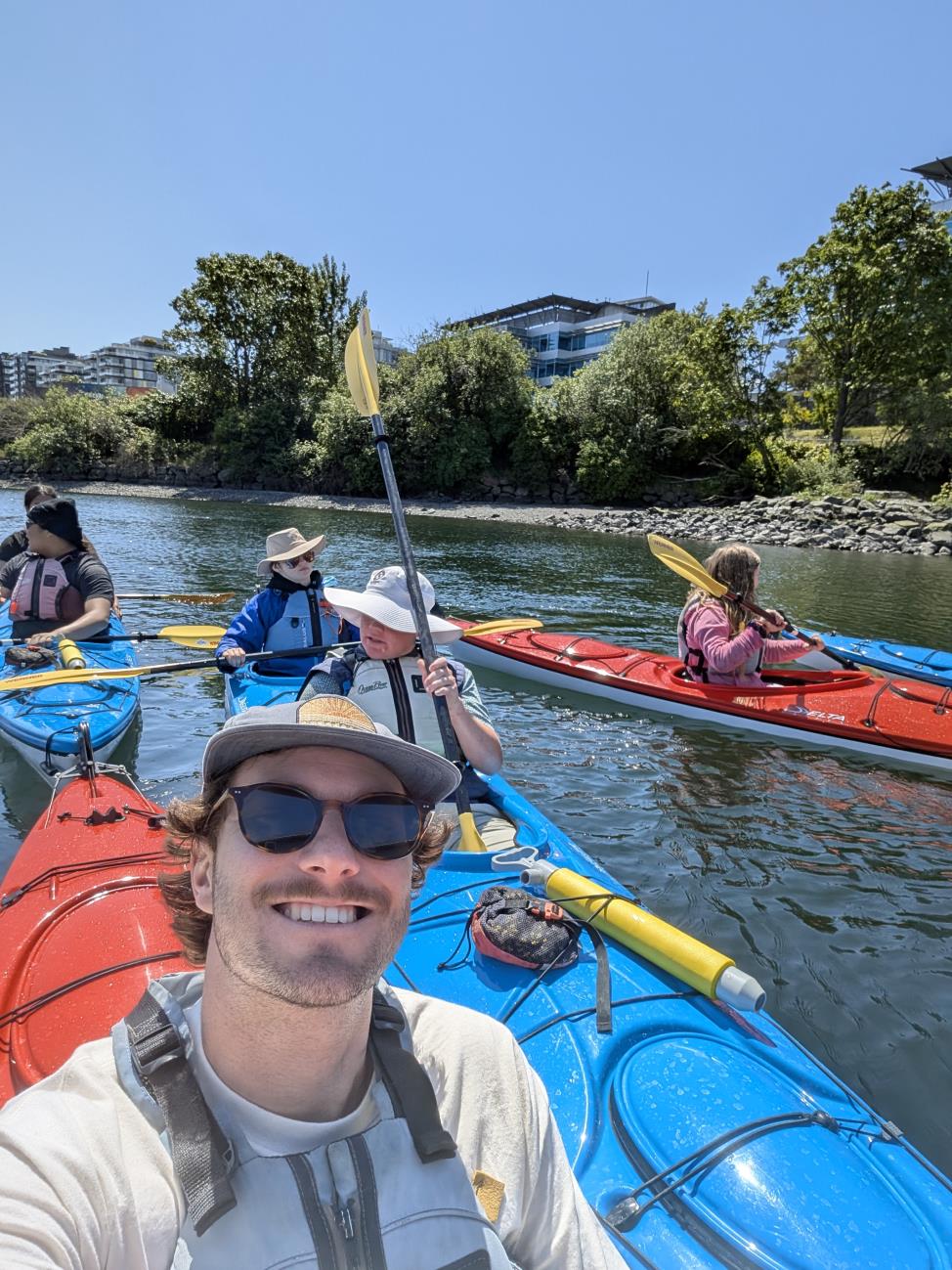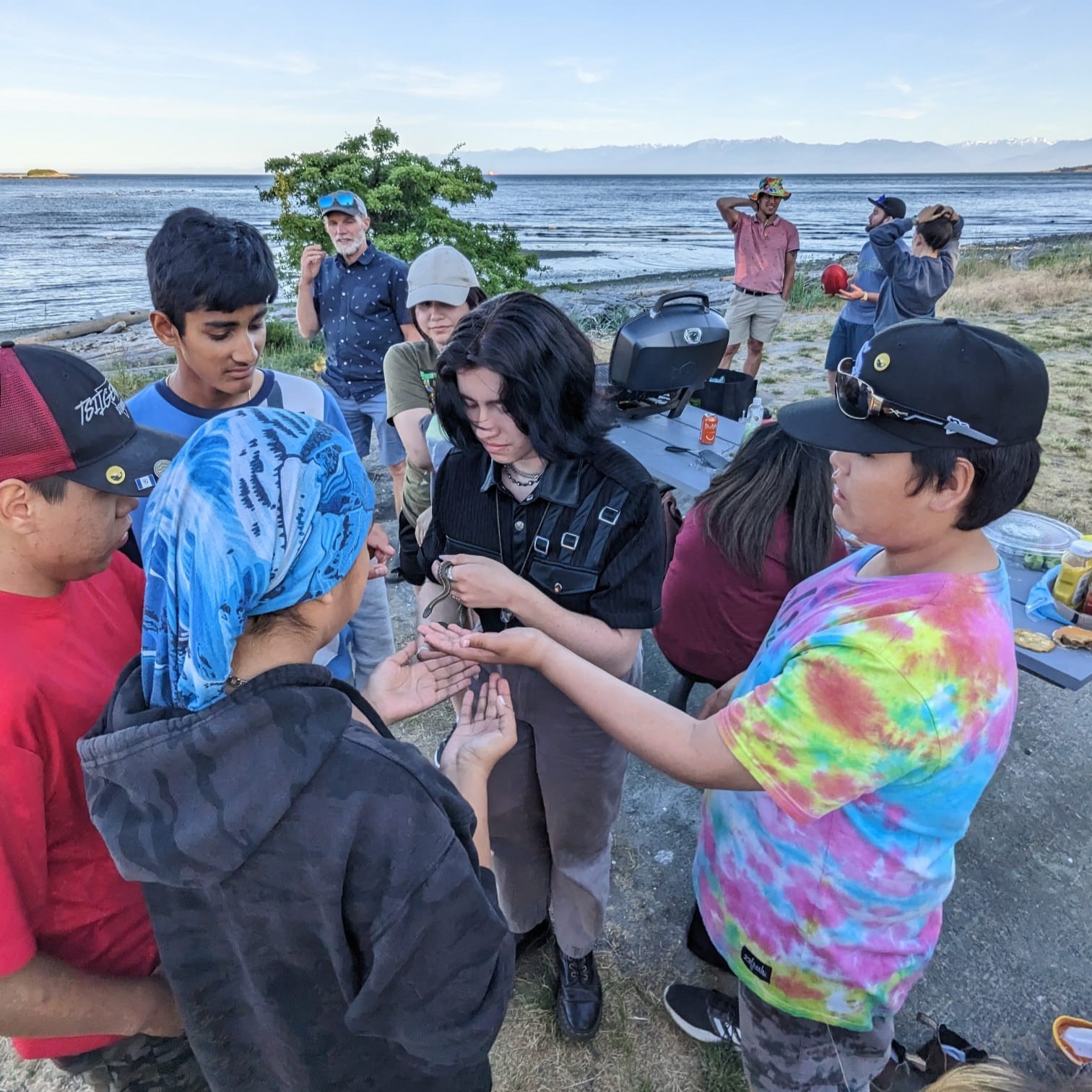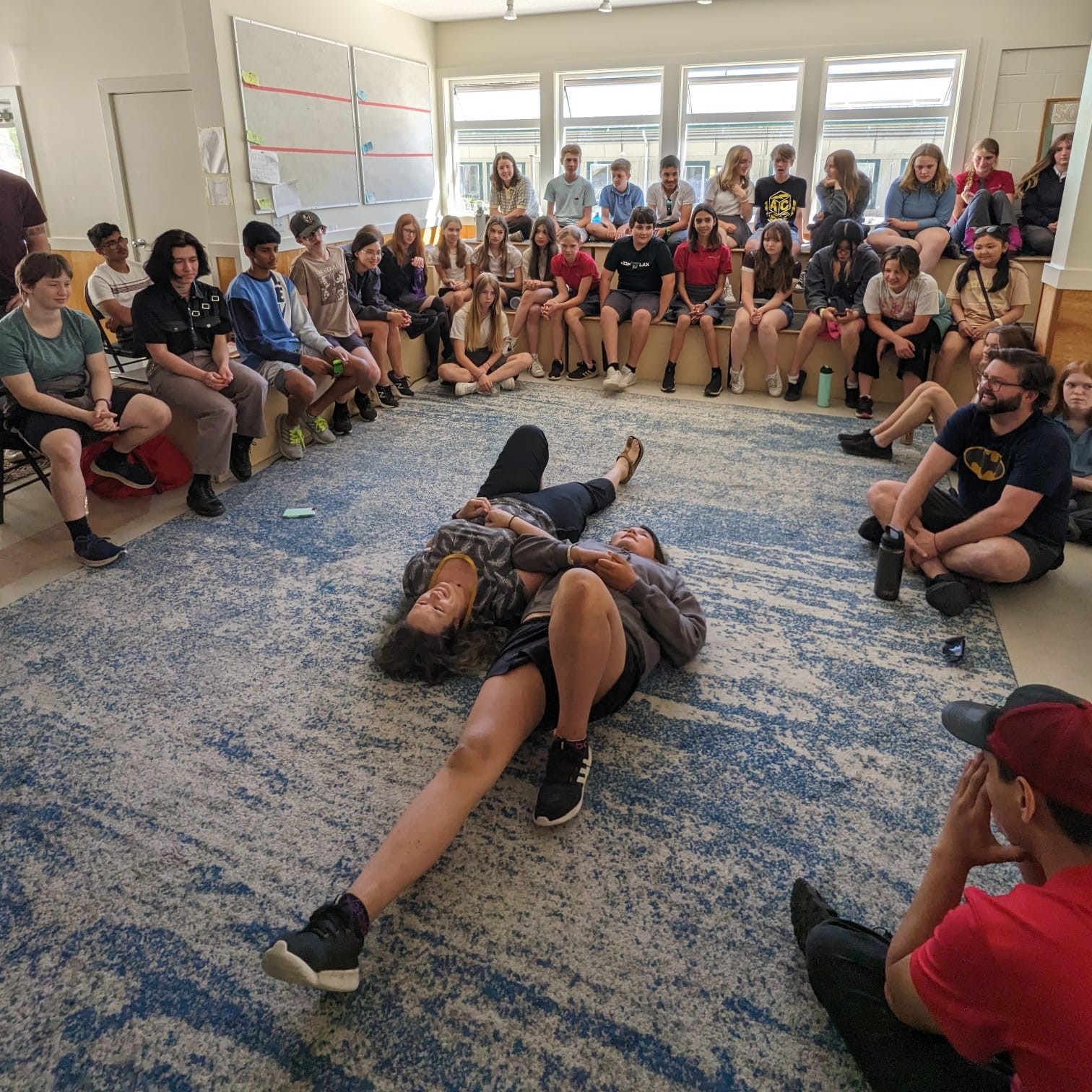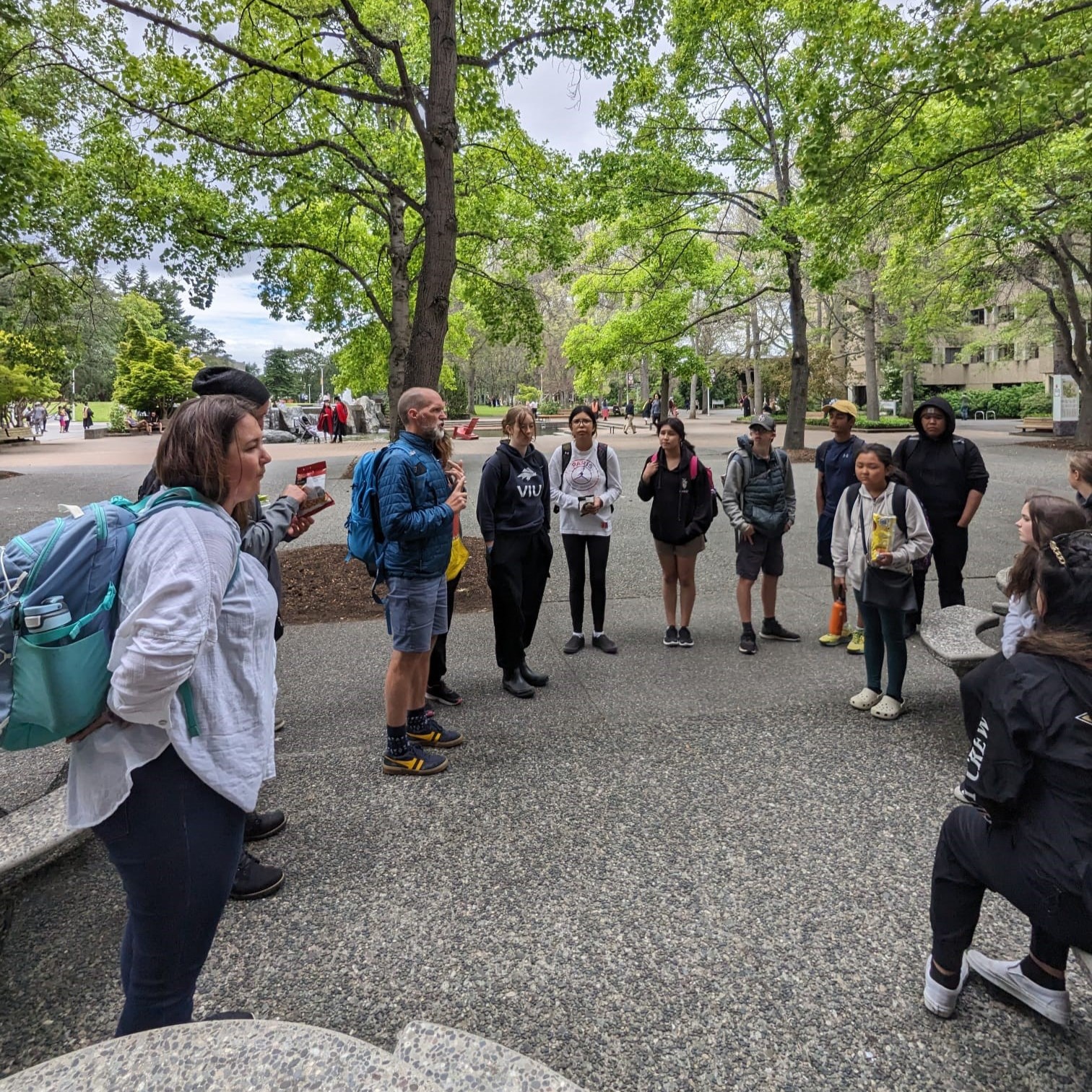
by Magnus Hanton | May 20, 2025 | High School, Highlight, Learning News, Program Bites
Hosting the Sagkeeng First Nation
Eagle Class Hosts Sagkeeng First Nation
Connection, Culture, and Coastlines
Last week, Eagle Class had the tremendous honour of hosting students from Sagkeeng First Nation in Manitoba for a week-long cultural exchange that was nothing short of extraordinary. This visit was part of our ongoing partnership through the Experiences Canada exchange program and served as a meaningful opportunity to deepen intercultural learning, foster friendships, and showcase the beauty and history of the West Coast.
The week began with a warm Westmont welcome. After arriving on campus, our guests were greeted at a special school-wide assembly where we acknowledged the lands of the Sc’ianew and T’Sou-ke nations. As a whole school, we celebrated the beginning of our shared experience. From there, we set off for a classic West Coast day: a walk along the beach, a challenging (and bonding) hike up Mount Metchosin, and a feast of locally caught salmon cooked on the Barbecue back at school. This full day outdoors grounded our new friends in the natural beauty that surrounds our school and gave them a taste, quite literally, of coastal life on the South Island.
On day two, we ventured into Victoria for a full day of learning and exploration. In the morning, students participated in a special Indigenous Innovations workshop at the Royal BC Museum, where they explored First Nations technologies and traditions through hands-on exhibits and discussion. The afternoon brought a truly unforgettable adventure: a private whale watching charter through the Salish Sea, generously provided at a discounted rate by Eagle Wing Whale Watching. To our delight, we encountered sea lions, and other marine wildlife, including a rare sighting of a sea otter! We capped the day off with dinner at Fisherman’s Wharf, where the salty sea air and floating homes created a setting that felt almost dreamlike.
The next day, our journey continued with a walking tour of downtown Victoria. With a focus on Chinatown, the oldest in Canada, we explored themes of migration, multiculturalism, and resilience, with special stops at Songhees Point and the Inner Harbour. Afterward, we switched gears with a kayaking adventure up the Gorge Waterway. Paddling together in tandem kayaks, students navigated the currents and wildlife with laughter and teamwork. The day concluded with a sunset dinner at the beloved Red Fish Blue Fish, a uniquely Victoria experience that delighted everyone’s taste buds.
Thursday took us to the historic grounds of Royal Roads University for a guided tour of the gardens, castle, and lagoon. The stories of the land’s past, military, educational, and Indigenous, offered rich insight into layered histories. That afternoon, we pushed our limits and conquered fears at WildPlay, where our entire group completed the Classic Course. We’re incredibly grateful to WildPlay for donating this adventure and for giving our students a chance to swing, climb, and leap among the treetops. It was a thrilling and confidence-building experience that none of us will soon forget.
On Friday, we travelled to East Sooke Park for a majestic coastal walk. The landscape felt alive around us, rugged bluffs, ancient arbutus trees, and breathtaking ocean views. The moment of the week came when a humpback whale surfaced just metres from the shore, feeding while a group of seals hunted nearby. We paused our own lunches to watch in awe as this marine drama unfolded, reminding us of the deep connections between land, sea, and story.
Our final evening brought the entire community together for a beautiful farewell BBQ. Families, staff, and sponsors gathered to share food, reflect on the week, and offer thanks. Students from both schools exchanged handmade gifts, heartfelt words, and plenty of hugs. It capped off a wonderful week in an incredible way.
Thank You!
This exchange would not have been possible without the generosity and support of many. We extend our deepest thanks to Eagle Wing Whale Watching for offering us an unforgettable marine experience at a generous rate, and to WildPlay for donating the Classic Course experience that brought so much joy and confidence to our group. We would also like to thank our generous donors:
- The Westmont PAC
- April Sim
- Westmont Alumni
- Carmalita Heron-Ewart
- Liz Koolman
- Janet Gray
- The Burns Family
- Mikaela Miller
To our families, volunteers, staff, and community members who cooked, drove, supervised, cleaned, donated, guided, spent money at bake sales or attended trivia nights, and welcomed with open arms, thank you. You helped create memories that will last a lifetime.
Want to learn more about our High School program?

by Magnus Hanton | Apr 17, 2025 | High School, Highlight, Learning News, Program Bites
Our Trip to the Sagkeeng First Nation
In April 2023, the Westmont High School students ventured to the Northwest Territories (you can read about their visit here), and Westmont had the privelage of having the NWT students explore the captivating landscapes and vibrant culture of Vancouver Island.
In 2024, Westmont was once again has been fortunate to be a part of an Experiences Canada exchange, this time with Biggar, Saskatchewan where students came to appreciate the diversity of this country.
In late February 2025 Westmont visited the Sagkeeng First Nation. We are a part of an experience Canada exchange with the Sagkeeng Anicinabe High School in Sagkeeng First Nation, Manitoba. As a part of this exchange, we will be hosting these students soon as they will be visiting Victoria in May.
On Monday we had a tour of the Whiteshell Laboratories nuclear power plant. The power plant is inactive and being decommissioned now, though when it was active in 1965 to 1985 it was used for research to test different materials to be used in future reactors. We got to stand on top of where the main reactor was located, learn about its time in use, and how the decommissioning process is going. We also got to have a tour of the Fire Hall they have at the nuclear power plant and we got to sit in their firetruck and learn about the tools they have to fight fires.
On Tuesday we split into two groups. We got to learn ice fishing on the Winnipeg River on the first day. Fishing is an integral part of the lives of the First Nations people of Sagkeeng, Manitoba. It has been a major source of food for them for a long time and we were very opportune to be taught by experts in their craft. We learned how to cut holes in the ice and how to bait our rods. It was fun to try to catch fish and a few people caught fish but only one from our group. Congratulations Jasper! We also got to see how to gut a fish right on the ice. Ice fishing taught us a lot of patience and fishing skills. I hadn’t fished a lot before this though I still found it exciting and everyone learned a lot.
On Wednesday our group went on a 30-minute Ski-doo ride into the bush, and we came to a campfire. Ww cooked marshmallows, had hot chocolate and played hide and seek before lunch. Then we had Bannock burgers and hotdogs for lunch and learned some Ojibwe words and phrases, as well as shared stories with our buddies. After that Black Sky, an elder who is also the Ojibwe language teacher, took us on a trail walk. He told us some of the Ojibwe names of the plants around us, as well as their traditional uses and had us pick some mashkiigobag (Labrador Tea) to make into a tea. We also learned about the names of animals and how to identify their tracks and traces in the bush.
On Thursday morning we were taught how to make ribbon shirts and ribbon skirts. These are important pieces of cultural attire that we were honoured to get the opportunity to make with guidance from experienced ribbon skirt and ribbon shirt makers. Some are used for daily wear, and some are used for cultural celebrations. We got to pick colors of ribbon, and we sewed them to the shirts and skirts. We also visited the local planetarium, and they had some excellent videos about first nations star stories projected on a dome. They told stories of constellations in the night sky from Cree and Anishinaabe cultures.
We then went into a sweat lodge led by an elder named Gilbert. Sweats are for physical and spiritual cleansing and healing. Gilbert sang songs, told stories, and gave us juniper medicine. He talked about the importance of sharing in these times of turmoil and the importance of sticking together, no matter how many horrible things happen in the world.
In the evening, we went to a round dance hosted by the community. A round dance is an event where drummers in the centre will sing songs and people will hold hands and dance in a circle around them. The round dance is a celebration for healing, honouring ancestors, celebrating life, and fostering community unity. The round dance at Sagkeeng was held to welcome us to their community and show how much they appreciated us coming to which we were extremely thankful and honoured. We were welcomed so beautifully, and they gave us a handmade beaded medallion with the community emblem on it and other gifts.
On Friday we drove into Winnipeg. We first went to the Manitoba Museum and learned about many things including the environment of current and past Manitoba and the people who have lived there over the ages. We then went to the Forks for lunch which is an indoor market where the Red and the Assiniboine rivers combine. It was a trading spot for thousands of years for indigenous groups and still is today. We then went to the Human Rights Museum and learned about the evolution of human rights across Canada. We also saw the Witness Blanket and the Canadian Journey’s exhibit. It would have been great to have stayed longer though due to time constraints we sadly had to leave. We learned so much about Canadian history and it was a great day to round off the trip. We flew back to Victoria on Saturday.
While on this exchange we learn a lot about the Sagkeeng First Nation and Ojibwe ways of life. We also learned lots of indigenous techniques and indigenous ways of knowing. We are really excited to host the students from Sagkeeng in May and to show them around Victoria and the South Island.
Want to learn more about our High School program?

by Magnus Hanton | Oct 10, 2024 | Charitable Impact, Events, Fundraising, Highlight, Learning News
At Westmont Montessori School, our commitment to charitable giving unfurls through both cherished traditions and innovative programs. Central to this endeavor is our annual participation in the Terry Fox Run (https://schools.terryfox.ca/79312). This is a poignant event that not only fosters community spirit but also serves as a living lesson in empathy, perseverance, and mutual support. Through this event, we unite under a common cause: to advance cancer research, honoring the legacy of a true Canadian hero. This gathering is not about accolades but rather a powerful demonstration of what we can accomplish when we come together. It sets a profound example of compassion and solidarity for our students.
Charitable Impact Program
Echoing this spirit of collective effort and the importance of contributing to society, Westmont launched its Charitable Impact Program in the 2022-23 school year. This innovative program is designed to further cultivate the seeds of generosity and social responsibility within our students. It is a complement to the values instilled by participating in the Terry Fox Run. By providing each class with a Charitable Impact Account, the program empowers students to explore, select, and support causes that resonate with them, offering $100 of charitable dollars each trimester to make a tangible difference in areas they feel passionate about.
The Power of Philanthropy
The integration of the Charitable Impact Program with our curriculum aims to deepen our students’ understanding of philanthropy and its impacts. This hands-on approach to charity, coupled with their engagement in the Terry Fox Run, illustrates the multifaceted ways they can contribute to the world beyond our school’s walls. These experiences underscore the lesson that everyone has something to give. Even small actions can create significant change when we act together.
Our school’s approach to education is holistic, nurturing not only academic excellence but also a sense of global citizenship and communal responsibility. By actively participating in events like the Terry Fox Run and through the structured giving facilitated by the Charitable Impact Program, our students come to realize the power of their contributions. They learn that giving back is not just a duty but a privilege that enriches their own lives as much as it does those they help.
Life-Long Giving
Looking ahead, we remain dedicated to weaving charitable endeavors into the fabric of our school culture. It is our belief that these collective actions—be they in memory of Terry Fox or through thoughtful donations to chosen charities—serve as critical stepping stones in preparing our students for a life marked by empathy, action, and a deep understanding of the collective impact we can achieve.
As we foster this culture of giving and grow together as a community, we are reminded of the values that bind us: humility, unity, and the enduring belief that in giving, we receive. Through the Terry Fox Run, the Charitable Impact Program, and myriad other acts of service, Westmont Montessori School is proud to be a place where the legacy of giving continues to inspire and shape our collective journey, demonstrating that together, we can make a world of difference.
Check out all of our recent news here!

by Magnus Hanton | Mar 15, 2024 | High School, Highlight, Learning News, Program Bites
Exchange Program: A Diverse Country, A Welcoming Community
In April 2023, the Westmont High School students ventured to the Northwest Territories (you can read about their visit here), and Westmont had the privelage of having the NWT students explore the captivating landscapes and vibrant culture of Vancouver Island.
In 2024, Westmont once again has been fortunate to be a part of an Experiences Canada exchange, this time with Biggar, Saskatchewan where students have come to appreciate the diversity of this country.
A New Perspective
When I learned about where we were going for our exchange, part of me was disappointed that it wasn’t Toronto or the Maritimes, it was Saskatchewan. I was quickly proven wrong by the incredibly strong community that welcomed us so warmly despite the storm and freezing cold. The community spirit of Biggar was a standout experience for the whole trip, which turned out to be an incredible and memorable experience.
When we landed in Saskatoon, we immediately felt the -38 as we stepped outside. We didn’t get to Biggar the first night, but we were lucky just to get to Saskatoon due to an ongoing blizzard. When we got there, Sean the principal chauffeured us from the airport to our hotel. It took three trips to get everyone there, but we eventually made it. In the morning, we met our wonderful bus driver – Ray – who drove us for an hour into Biggar. This was our first real look at Saskatchewan. We immediately took in the flatness of the landscape, and the mountains of blowing snow.
When we arrived, we got a warm welcome from the school and got to meet the students in person. We went into the gym and played icebreaker games so we could learn the names of the other students there and get to know them better. We made pizzas with our buddies for lunch and after that we split into groups to visit the Credit Union, which plays a huge role in the community there providing funding and helping out for over 75 years. We also got to meet the Mayor of Biggar and he told us about how the town was built and about the infrastructure behind the town’s development.
After that, we got to meet the mayor, our groups joined up and we went to the Biggar Museum & Gallery. We learned about the history of the town and how it came to be. There we learned about the Grand Trunk Pacific Railway, and who Biggar was named after. We also learned about the town’s famous slogan: “New York is Big, but this is Biggar.” We had a dinner of spaghetti in the school and played basketball in the gym until our homestay families picked us up.
The next day we got to go to Saskatoon. There we went to the Western Development Museum. Some of my favourite exhibits were the historical cars, the train you could go in, and the mock 1900s town including the jail cell. There were also very detailed exhibits on farming equipment from the Industrial Revolution to now. There were many fun interactive displays too. This museum taught us a lot about the story of Saskatchewan, and how vital farming is to both the province and the country. After the museum we went to a skating rink right in the center of the city surrounded by some very cool old architecture, it was kind of a park but covered in ice. We skated for about forty minutes then we drove to the University of Saskatchewan, which is Saskatchewan’s biggest university. We got a tour of a lot of the buildings and after the tour we got some more background information about the history of some of the rooms. After that we went home to our homestays.
On Thursday we started the day by going bowling at Biggar’s local five pin bowling lanes. We also got to learn about some of the fun things that Biggar locals do to wind down like playing sports and horse riding in the summer. In the afternoon we went on a Goosechase, which is an online application where you run around the town and taking photos with various Biggar landmarks such as a statue of the Hanson buck (the highest scoring buck in history), the water tower, and the credit union, or completing wacky tasks in certain locations. This was a really special way of experiencing the town and the weather, as well as connecting more with our Biggar buddies.
On Friday we got invited to participate in the school’s annual Metis winter festival. We learned some traditional Metis practices such as beading and dot art. Both of which were fascinating to learn about. We got to try dot art for ourselves, and it was very satisfying. We also got to spend a lot of time outside snowshoeing and hearing Metis stories by a roaring fire. At the end of the night, we had tacos in a bag with all of the homestay families together and got to watch all of the other team’s videos from the Goosechase and play basketball in the gym. The next morning, we had to say goodbye to our homestay families and the community as we travelled back to Victoria.
Even if a destination is not on your bucket list, it can always be an incredible experience. It doesn’t matter where you end up, it is who you are with and who you meet along the way that makes an experience what it is. We met some amazing people and shared some incredible stories and experiences with them. This was a wonderful journey, and we want to thank Experiences Canada, Biggar Central School 2000, and the community of Biggar, for allowing for this exchange to happen and welcoming us into their beautiful community.
Written by: Merric Hanton
Edited by: Eagle Class
Photos Selected by: Ares Van Koeveringe and Morgan Friest
Want to learn more about our High School program?

by Magnus Hanton | Jun 20, 2023 | High School, Highlight, Learning News, Program Bites
An Exchange Program: New Perspectives
Join us as we delve into the remarkable journey of students from Westmont High School and Chief Paul Niditchie School (CPNS). In April 2023, the Westmont High School students ventured to the Northwest Territories (you can read about their visit here), and now it is CPNS students’ turn to explore the captivating landscapes and vibrant culture of Vancouver Island. Discover their immersive experiences, profound insights, and the meaningful connections they forge, as they navigate the complexities of colonization and embrace cultural inclusivity.
Picture this:
You are next to a 130 foot tall totem pole in the capital of British Columbia, and then, you walk over to the sign and it says “Memento of the nation’s infancy, symbol of a proud race, monument to a rare native art, proof of united community interest and the purest form of Canadiana.” What do you think of this quote? Is it true? Were residential schools proof of a united community interest? When we first read this sign, our hearts sank. It was quite clear that this sign was not written by an Indigenous person, but rather, a British settler talking about a Indigenous form of art. This represents the lack of perspectives on Vancouver Island and across Canada as a whole. This trip was a form of truth and reconciliation, and honouring First Nations culture in Canada, admiring and thinking about what is there, and questioning what isn’t.
The class of Chief Paul Niditchie School (CPNS) toured around Vancouver Island for the first time. For them, it was an eye-opening experience. On the first day of their visit they hiked through Metchosin and visited the mayor, where they learned about the skills required to be a successful political figure and how an area, like Metchosin is lead. We picked up some valuable information on how communication and dealing with people is the single most valuable skill in politics.
Both classes learned about the memorialisation of colonisation and its effects on Indigenous perspectives, discrimination, and lack of representation in the Legislature and around downtown Victoria by viewing murals and signs that discussed Indigenous topics.
The CPNS and Westmont classes participated in local activities in Victoria as well, such as eating local seafood, boating on the Salish Straight and seeing local wildlife including a pod of orca whales.
On Thursday CPNS and the Westmont High School drove down to Royal road university and walked out to Hatley Castle. There we relaxed in the sun and had a conversation about the memorialization of colonisation and Indigenous culture. Then, we walked to Juan de Fuca and went to the Wild Play high ropes course. It is stunning to be up in the treetops of BC’s magnificent forests and to fully experience and be immersed in the island’s natural beauty. Then, the Westmont High School and Middle School and CPNS sat around the campfire and told stories.
During Friday, we toured around UVIC to experience what secondary schooling could look like for children in their future. We learned about what daily life was like for a student and what benefits UVIC would provide. We were also introduced to The First Peoples House, ‘A home away from home’ for Indigenous students to study, work, and hold traditional events. Later, we bussed to the Pedersen’s house where they graciously hosted a barbeque where we ate tacos in a bag and had a wonderful time playing games and socialising.
On Saturday we started off the day by going to the Malahat Skywalk. The Skywalk was made as a way to see the beauty of Vancouver Island from above the treetops. We took a bus from the school up there, got our tickets and then walked on a boardwalk through the trees until we reached the base of the Skywalk. We walked up 20 metres to get to the top and the views were breathtaking. You could see so far and they had a net that you could stand on to see straight to the ground. There was also a slide as an option to get back down to the ground which was very amusing. After that we came back to school to let the CPNS students bond with their host families and pack for the next day. Then for dinner we went to the Lang’s house. We had a wonderful dinner of Salmon burgers and vegan burgers. After dinner we all played games together such as Avalon and Battleship. Finally we all went home to our families. The week was slowly coming to a close and this was our last full day together and many of us were wishing that there were a lot more full days ahead.
On the very last day of our tremendous experience with the Northwest Territories students, we started our day off with kayaking in the Victoria Gorge having a phenomenal time gliding through the Pacific Ocean. We saw various types of wildlife including seals, and various birds such as blue herons, seagulls and crows, even though the weather made us feel cold and unpleasant we still had a wonderful time. Later we bussed back to our school and had a barbeque lunch with the students, families, and individuals who helped us make this encounter a remarkable experience.
Throughout our week with the CPNS students we continuously learned about different perspectives and formed new bonds. Some key takeaways include learning about the Indigenous cultures on Vancouver Island and seeing how much of their culture is excluded in historical Canadian literature. This brought home the point that you have to read between the lines and look for what isn’t there, rather than what is there.
Thank you for reading!
By Agneya Pradhan, Alwynn Waddington,
Merric Hanton, Ani VanKoeveringe
Want to learn more about our High School program?



